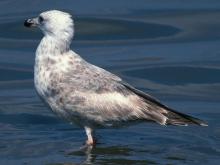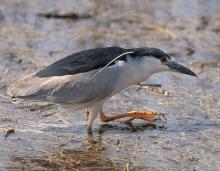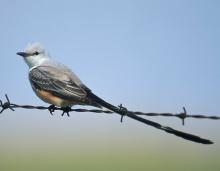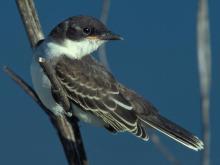Birds
Media

Species Types
Scientific Name
Larus argentatus
Description
Herring gulls are one of the three most common gulls found in Missouri. Adults can be told from our other common gulls by their pinkish legs and yellow bill with a small red dot near the tip.
Media

Species Types
Scientific Name
Nycticorax nycticorax
Description
Stocky and short-legged compared to other herons, the black-crowned night-heron has a black crown and back, gray wings, and whitish-gray underparts and head.
Media

Species Types
Scientific Name
Tyrannus forficatus
Description
One of Missouri’s most breathtaking birds, the scissor-tailed flycatcher captures insects in midair, then flits back to its perch. You’re most likely to see it in summer, in our southwestern prairies.
Media

Species Types
Scientific Name
Tyrannus tyrannus
Description
The eastern kingbird’s spirited territorial defense, tidy, black-and-white plumage, and distinctive, fluttery flight have long captured the attention and admiration of people.
Media

Species Types
Scientific Name
Charadrius vociferus
Description
The killdeer is a familiar “shorebird,” but we usually don’t see it near shores! Killdeer prefer open, flat, rather dry areas with short grass, including flooded crop fields, lawns, and sports fields.
Media

Species Types
Scientific Name
Buteo lineatus
Description
The red-shouldered hawk is associated with forests and near water, in places where the lower part of the forest canopy is fairly open. They sit on tree branches and watch for movement on the ground.
Media

Species Types
Scientific Name
Buteo platypterus
Description
The broad-winged hawk is stocky, with a large head and short tail. They are often seen migrating in large flocks. From below, note the pointed wingtips and broad black trailing edge to the pale wings.
Media

Species Types
Scientific Name
Bubulcus ibis
Description
Cattle egrets are small, stocky white herons. Adults have yellow bills and legs. At breeding time, the legs and bills turn red, and the feathers of head, breast, and back are orangish tan.
Species Types
Scientific Name
Parkesia motacilla (formerly Seiurus motacilla)
Description
The Louisiana waterthrush is a warbler that typically walks along the banks of flowing streams, pecking at insects and other small invertebrates. Its loud, ringing song is distinctive.
Media

Species Types
Scientific Name
Setophaga americana (formerly Parula americana)
Description
The northern parula is a small summer resident warbler with gray-blue upperparts, two white wingbars, and a greenish-yellow patch on the back. The male has black and chestnut bands on the yellow breast.
See Also







Media

Species Types
Scientific Name
Hemaris diffinis
Description
The snowberry clearwing is a moth that confuses people because it looks like a bumblebee and flies like a hummingbird!
Media

Species Types
Scientific Name
Hyles lineata
Description
The white-lined sphinx moth sometimes confuses people because it flies, hovers, and eats from flowers like a hummingbird. The adults often fly during daylight hours as well as in the night and are often found at lights.
Media

Species Types
Scientific Name
Darapsa myron
Description
The Virginia creeper sphinx moth is common in woods and brushy areas and comes to lights at night. The larvae eat Virginia creeper and grape leaves.
Media

Species Types
Scientific Name
Perimyotis subflavus (formerly Pipistrellus subflavus)
Description
Tri-colored bats, formerly called eastern pipistrelles, are relatively small and look pale yellowish or pale reddish brown. The main hairs are dark gray at the base, broadly banded with yellowish brown, and tipped with dark brown.
Media

Species Types
Scientific Name
Myotis grisescens
Description
Gray myotises are difficult to distinguish from other mouse-eared bats. A key identifying feature of the gray myotis is that its wing is attached to the ankle and not at the base of the toes. It’s an endangered species.
Media

Species Types
Scientific Name
Myotis lucifugus
Description
The little brown myotis (little brown bat) is one of our most common bats, but populations are declining. White-nose syndrome has taken a heavy toll in northeastern states. This species is now listed as vulnerable across its range.
Media

Species Types
Scientific Name
Myotis sodalis
Description
The Indiana myotis, or Indiana bat, summers along streams and rivers in north Missouri, raising its young under the bark of certain trees. It is an endangered species.
About Birds in Missouri
About 350 species of birds are likely to be seen in Missouri, though nearly 400 have been recorded within our borders. Most people know a bird when they see one — it has feathers, wings, and a bill. Birds are warm-blooded, and most species can fly. Many migrate hundreds or thousands of miles. Birds lay hard-shelled eggs (often in a nest), and the parents care for the young. Many communicate with songs and calls.





















